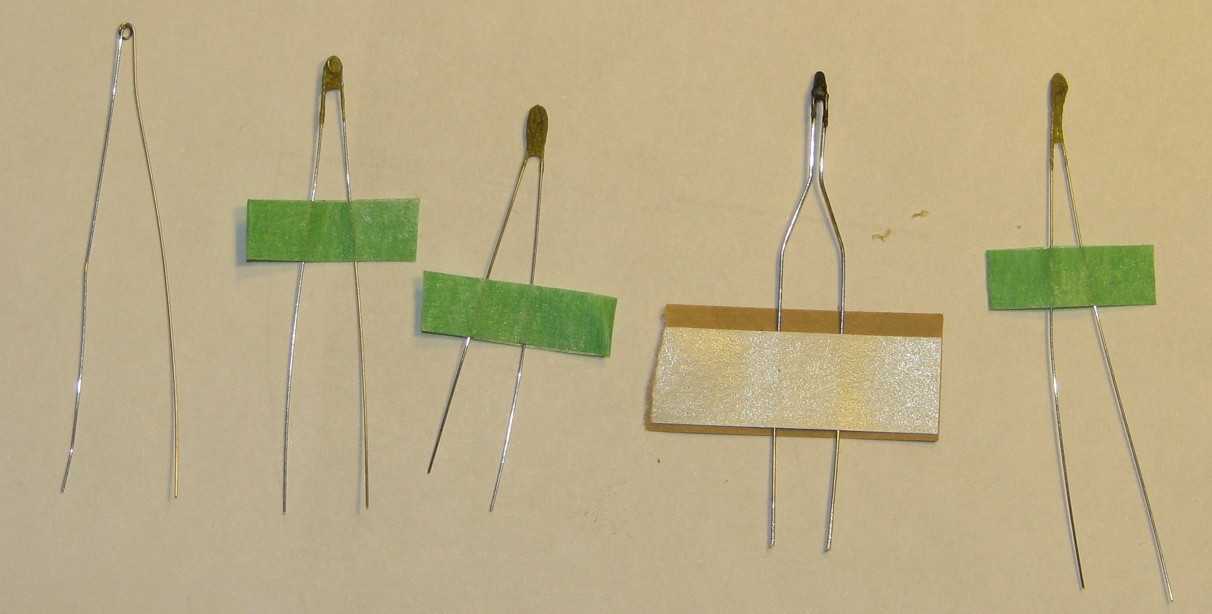George,
Neat way to make Estes like igniters. Could you use 24, 26, or 28 AWG nichrome? I have some to try. I am not sure what volt/ amp that would require.
Chuck
The largest gauge I have is 30. I will say that these get hot REAL fast, using the "12 volts" delivered by a 3 cell (11.1V) LiPo battery that has a capacity of 2200 mAh (2.2 Ah). I have not tested any other power source but they'd work with more powerful batteries like 12V Gel Cells and car batteries. Given how fast they get hot, they would probably work on lower capacity LiPos and say 2 cell 7.4 V Lipos.
They might work with 12V of eight AA batteries, or might not. I'd be surprised if they worked with 6V of four AA's. So if one wanted ignitors that would work well with small batteries, they'd probably want smaller diameter nichrome.
Take note that not all batteries are alike, for a given voltage. Typical cheap 1.5V AA's do not deliver very much current. Alkaline AA's deliver a little bit more current than non-Alkaline. Nicads, the AA size cells only have 1.2v per cell, but they deliver a lot more current than Alkaline AA's. And those all have the same physical size.
Lithium Polymer batteries deliver a lot of current for their size. But of course the larger the capacity, the more current that a LiPo battery will deliver. For example a theoretical 550 mAh Lipo would deliver about 25% as much current as a 2200 mAh Lipo, all other things being equal (same manufacturer, same discharge rating, etc.). I am using 3 cell (11.1V) 2200 mAh Lipo's because those are very popular for a lot of R/C models, which I have access to. Before then, my launch battery of choice was a 4.5 to 5 Ah size 12 volt Gel Cell.
So, a person could make up an ignitor tailored for a certain battery type. Like say make up ignitors that work fine with four AA Alkalines, like the Solars are just able to use when the batteries are fresh enough. But the very fine bridge wire the Solars use, is a PITA to replicate by soldering longer leads to it (The Solars are spot-welded by some sort of machine), and an ignitor made up out of just that fine bridge wire nichrome would be too wimpy and fragile. So for home-made ignitors for BP motors like Estes & Quest, , it would make more sense to upgrade to a more powerful battery that can fire some dumb-simple and easy-to-make ignitors.
Now, the flip side, since you were asking about larger diameter nichrome because you have 24 or 26 or 28...... it depends on the battery you have in mind. My 30 gauge ignitors get so hot so fast that I'm sure 28 gauge would work with these lipos. Maybe 26. Now if we are talking 12V car battery, then 24 gauge nichrome would probably work. But of course if you have any of that, it is easy enough for you to test. Just cut off a 3-4" length , hook launch control system to it, and press the button to see if it gets orange-hot pretty quickly, or not.
Of course the larger the gauge, then the larger the coil is going to end up being, unless you try a smaller mandrel diameter. A larger coil might be a problem for fitting thru the throat of 13mm A3 motors, but probably fine for 18mm motors. I wanted for these to work with any Estes/Quest BP engines, other than MicroMaxx.
BTW - I made up 55 of those ignitors. I did fly one Sunday to test fly a rocket, and the ignitor worked fine. Of course a single test is not a statistically useful reliability data point, unless it had failed. And I did not make these to be more reliable than Solar. If they are 10% less reliable than a Solar, that would be fine since my pan is to use them for sport flying and test/practice flying when misfires are not a big deal. For contest flying i'll stick with solars and old Q2G2's.
- George Gassaway





